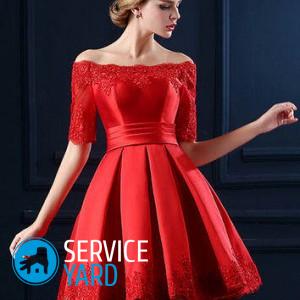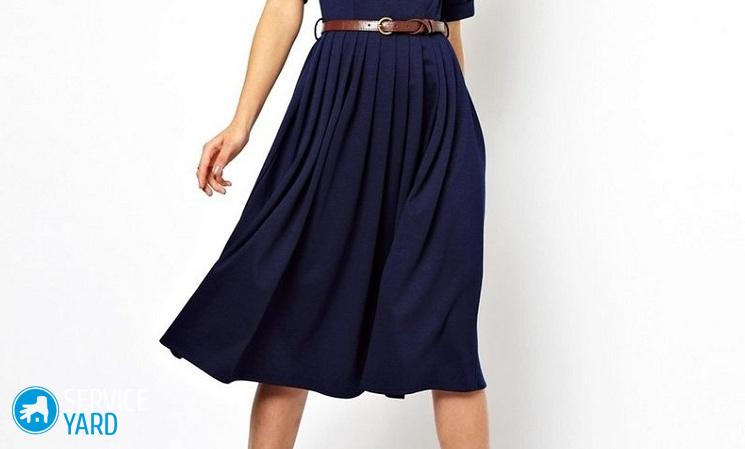How to sew a dress with a skirt-sun?

The skirt-sun has not gone out of fashion for many decades. It can be both an independent wardrobe item, and part of the dress. Sewing such models is not difficult, especially now, when the choice of fabric in stores is large enough so that even an inexperienced seamstress has the opportunity to do something interesting without any problems. How to sew a dress with a skirt-sun will be discussed in our article.
to contents ↑Who is it suitable for?
Women have different shapes, but at the same time, everyone wants to be attractive. A dress with a sun skirt is a very spectacular thing, suitable for almost everyone, but you need to be very careful about the choice of fabric. To begin with, look in the mirror and soberly evaluate the features of your physique. You may have a figure:
- slim;
- dense, but proportionate;
- full;
- with broad hips but small breasts;
- with narrow hips and large breasts.
Slender women can afford both a long dress with a wide skirt and a short one. You can also take any fabric from a simple chintz to velvet. A thick skirt with flowing knitwear will look better on a thick or full woman, she will lie in beautiful folds, visually lengthen the figure and make her slimmer.
As for women with wide hips, then, as they say, options are possible:
- you want to visually narrow your hips;
- You want to emphasize your forms and focus on them.
For the first case, a skirt-sun does not suit at all, a dress of a direct silhouette with a very low waist is preferable. But if you want to draw attention to your wide hips - feel free to sew yourself an evening dress with a skirt-sun, you can even multilayer in the manner of a ballroom.
to contents ↑Purpose of the dress
Before you sew a sun dress with your own hands, determine where exactly you will wear it. It can be:
- in the evening;
- business;
- everyday;
- for summer holidays.
Evening outfit
The choice of fabric depends on the destination. Soft evening materials are suitable for evening models:
- silk;
- chiffon;
- knitwear;
- velvet;
- velours.
Important! The fashion trend is wide tulle skirts, the so-called “shopenki”. They are also sewn, like the sun or half sun, with or without lining. Fatin is good in that you can make even a very long skirt without a seam at all. As for the dress, the top may be from knitwear or silk. For many models, a fastener at the waist is necessary - it can be done side or back.
Casual models
There is no fundamental difference between everyday and business clothes - in any case, with regard to the choice of materials. The exception is denim, which is good for casual wear and not suitable for business wear.
In either case, woolen and mixed fabrics, stretch, fine synthetics, tartan and much more are suitable. The knitwear is truly universal - its assortment is such that you can choose for any model.
Dress for summer holidays
For summer, natural fabrics are preferable:
- chintz;
- satin;
- batiste;
- staple;
- linen;
- natural and artificial silk.
You can find suitable mixed materials with a high cotton content, and “smart” fabrics, in the clothes of which you will feel comfortable in any weather.
to contents ↑Important! Regardless of which material you choose, try to keep the width at least 150 cm.Then the skirt with almost a guarantee can be cut out entirely.
We make a pattern
How to sew a dress for the sun, if the magazines did not find a suitable pattern? It's okay, you are quite able to cope with such difficulties. For a skirt in general, no pattern is needed - it is laid directly on the fabric.
Important! If you are afraid, then you can try first to make a piece of paper, for which roll graph paper is most suitable, but in principle the wallpaper remaining after the repair will also work.
You still need:
- pencil (if you cut directly onto the fabric, then chalk);
- a piece of twine or any other rope;
- button.
Merki
But first, take measurements, and then you have to do math. You need to know:
- chest girth;
- waist circumference
- side seam length from armpit to waist;
- the length of the back from the seventh vertebra to the waist;
- the distance between the waist and chest lines;
- skirt length.
to contents ↑Important! Measurements are best taken once and recorded. If you decide to seriously engage in sewing, you will need them repeatedly.
Skirt drawing
Now it comes to arithmetic. The skirt pattern-the sun is a ring. You know the length of the inner circle, now you need to determine its radius. We recall the formula P = 2nR, where P is the circumference of your waist, and n = 3.14. Accordingly, to find the radius, you need to divide the waist circumference by 6.28.
Important! If the integer fails, round up.
To calculate the radius of the larger circle (bottom hem of the hem), add the length of the skirt to the result. Now we make a drawing, or cut it directly onto the fabric:
- Fold the cut for the skirt in half.
- Find the middle of the fold line and draw a chalk dot.
- Tie a chalk or pencil to one end of the cord.
- Attach a zero centimeter mark to the pencil.
- Measure the length of the product on the cord.
- Mark the mark on the cord with the mark on the fabric.
- Stick a button at this point.
- Draw a semicircle.
- From the same point, draw a second semicircle - a notch, the radius of which you calculated.
- Cut the part, leaving allowances along the hem and waist.
- On the inner circle, designate a place for a cut under the zipper, but do not cut anything yet.
to contents ↑Important! If the dress is entirely made of knitwear, zipper is not needed.
Bodice
It is not always possible to make a bodice pattern directly on the fabric. Although the designers offer a lot of interesting models from knitwear, where the pattern is not needed at all, but the patterns are still better to do. In order to build it yourself, you need accurate measurements and a fair amount of free time. If it is not possible to order patterns in the studio, you can do the following:
- Find a suitable blouse in your wardrobe - unnecessary, but in good condition.
- Cut the buttons.
- Spread it thoroughly, and not only the seams, but also all the tucks.
- Remove all threads.
- Cut or iron the allowances and fastener.
- Cut the grooves.
- Iron the parts well.
Important! As the patterns, you can use the parts themselves, but nothing prevents them from being transferred to paper or thick plastic film.
You do not need all the details. Be sure to save:
- 1 shelf part;
- 1 backrest part;
- 1 sleeve;
- cuff;
- collar.
With this set, you can cut anything from a nightgown to a ball gown.
to contents ↑Important! In order to sew a dress from knitwear, you can take not a blouse, but a T-shirt.
Fabric calculation
To sew a dress with a skirt-sun for a girl or an adult woman, you need to understand how much material is needed for this. For an adult model, it is best to buy material with a width of at least 150 cm, then the calculation of the fabric will be extremely simple.
For a short skirt (mini or knee length):
- Multiply the length of the skirt by 2.
- Add the bodice length from shoulder to waist.
- Add 15 cm to the result for the seams, edges and loose fit.
For style with a long skirt:
- Multiply the length of the skirt by 4.
- Add twice the bodice length.
- Add 30 cm.
to contents ↑Important! When sewing from stretch, stocks are not needed.This calculation method is also suitable for a short skirt made of narrow fabric.
Start sewing
To sew a dress with a skirt-sun with your own hands, in addition to fabric and patterns, you will need some more things:
- typewriter;
- sharp scissors;
- needle sets - for the machine and manual sewing;
- threads matching fabrics in color and quality;
- chalk or soap;
- iron;
- tailor pins.
to contents ↑Important! Knitwear needs a special needle.
Dress made of natural fabric
Regardless of style, it is better to make such a dress with a zipper at the waist - cotton, linen, wool and mixed fabrics do not stretch. It is better to sew a zipper in the back, in the midline.
At the same time, it is better to make the skirt with a seam so that it does not puff up where there will be lightning. There are two ways to do this:
- if the fabric is thin - the ring must be cut;
- if the skirt is made of denim - mark the place of the seam with chalk, fold the blank in half along the drawn line and lay a basting seam 1 cm from it, capturing both layers of fabric, and for the zipper, make an incision strictly along the line.
Open the bodice
If you have already prepared the skirt, you can start cutting the bodice. Much depends on whether any other fastener is provided, other than the one that will be located at the place of attachment of the skirt and bodice.
Important! If this is your first time sewing, it is better to choose a style without fasteners and without sleeves.
We carry out:
- Fold the fabric in half lengthwise.
- Overlay the shelf pattern so that the middle line coincides with the fold line.
- Attach the pattern with tailor pins.
- Circle the pattern strictly along the contour, taking into account all the tucks (a baby dress is made without tucks).
- Circle the part again, making allowances of 1 cm in all sections, do not touch the darts anymore.
- Circle the back so that you get 2 parts. Since the zipper will be at the back, be sure to leave allowances where the middle seam will be.
Cutting Parts
Cutout and armholes will need to be processed. In this case, a trim trim is most suitable:
- Place the part of the shelf on the fabric strip so that the cutout fits on the strip completely.
- Circle the neckline.
- From the edges of the cutout, draw straight lines that should coincide with the shoulder seams - you have an arc.
- At a distance of 3-5 cm, draw a second arc parallel to the first, until it intersects with the shoulder seams. Do not forget about allowances for a hem and on seams.
- In the same way, make tailoring for backrest and armhole.
to contents ↑Important! Details from knitwear can simply be processed with an overlock, and if the dress is made of heavy fabric, you can make cut ribbons from something thin, but durable.
Assembly:
- It will be much more convenient to assemble parts if you pre-process them. Overcast all sections of the bodice except the bottom with an overlock or overcast manually. The top of the skirt should remain unprocessed.
- Sweep the tucks.
- Sweep the middle seam of the back to the point where the zipper will begin.
- Sweep the shoulder and side seams.
- Try on what you got.
- If necessary, adjust the tucks.
- Stitch the undercut.
- Stitch the middle back seam to the point where the zipper will begin.
- Stitch the shoulder and side seams.
- Flatten the allowances.
Trimming
Before sewing on a skirt, it is better to process the neck and armholes. External arcs can be hemmed or processed with an overlock - in the latter case, you do not need to trim them:
- Stitch the shelves and backrests along the shoulder seams, iron allowances.
- Align the inner ring with the neckline of the shelf and back, folding the parts with their faces facing each other, and sweep.
- Stitch the trim on the bodice.
- Carefully tighten the neck.
- Sew a decorative stitch along the edge, close to the seam.
- Lay another decorative stitch at a distance of 1-3 cm from the first.
- Handle the armholes in the same way.
We attach the bodice to the skirt
Before final assembly it is necessary to iron allowances where the lightning will be on the wrong side:
- Sweep the zipper so that the “dog” is on the front side.
- Stitch the zipper - this is much more convenient than stitching it in an already finished dress (although you can change the sequence).
- Sweep the bottom of the bodice and the top of the skirt together.
- Stitch the details.
- Iron allowances on the side of the skirt, you can cut them short and work together with overlock.
- Hem the hem if you haven’t done it before.
Knit dress
Sewing from knitwear is both easier and more difficult than, say, cotton. It is more difficult to work with the material itself, but operations have to be performed less. In this case, you do not need either a trim trim or a zipper. The skirt blank itself is a ring without a cut, and the assembly order will be as follows:
- Process absolutely all slices.
- Sweep the skirt to the bottom of the bodice.
- Sweep the bottom of the bodice to the top of the skirt on the wrong side.
- Stitch the details.
to contents ↑Important! Tucks on a knitted bodice are optional.
Another knit dress
Knitwear is an absolutely wonderful material that drapes wonderfully. And this means that the bodice can be made without paper patterns at all, by doing something interesting in the Greek style. The skirt is cut in the same way as in all other cases. As for the top, the sequence will be as follows:
- Cut a piece of knitwear with a length equal to twice the length of the bodice from the shoulder to the waist.
- Fold the piece in half, aligning the edges.
- Find the middle of the fold and make a mark.
- From this mark, make a cut parallel to the edges, to an arbitrary length (the cut can be both front and back).
- In one and the other direction, measure 10 cm and also make cuts, but along the fold line.
- Treat all sections except the edges with an overlock.
- Align the folds on the fold line with symmetrical folds on both sides and chop them with tailor pins or sweep them.
- Try on your creation and adjust the creases.
- Sweep the folds also along the lower cut - note that the bottom of the bodice should exactly match the top of the skirt in size.
- Sew folds.
- Try on the bodice and outline the places where the armholes end.
- Sweep and stitch the side seams from the waist to the ends of the armholes.
- Sew the bodice to the skirt.
Stock footage
Now it’s time to update your wardrobe, because you are armed with several options for models of skirts and dresses with a skirt-sun, which will certainly transform your look and make it more feminine and at the same time spectacular.
- How to choose a vacuum cleaner taking into account the characteristics of the house and coatings?
- What to look for when choosing a water delivery
- How to quickly create comfort at home - tips for housewives
- How to choose the perfect TV - useful tips
- What to look for when choosing blinds
- What should be running shoes?
- What useful things can you buy in a hardware store
- Iphone 11 pro max review
- Than iPhone is better than Android smartphones






